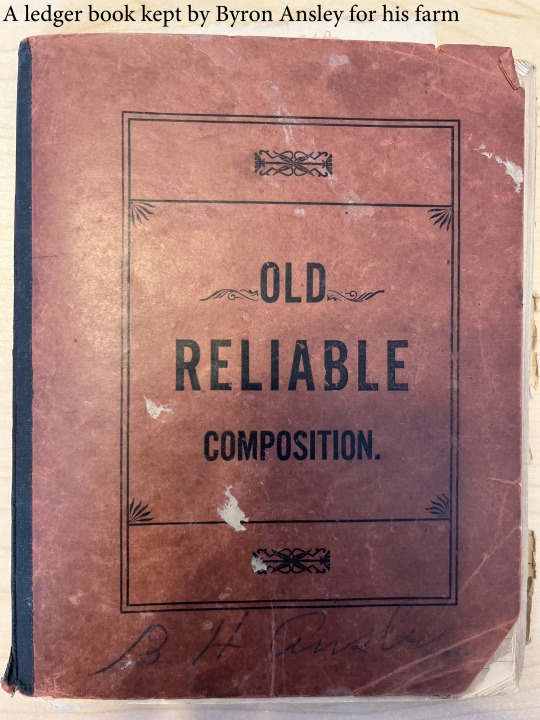#byronansley
Text
The good ol’ days of Italy Hill
By Jonathan Monfiletto

“How much more vividly we recall to memory incidents that happened during our younger years of life than we can events of much more importance that take place in later years.”
With this observation, Byron Ansley – writing as B.H. Ansley – began the first in a series of at least seven essays that appeared in The Chronicle-Express between March 1936 and May 1938. Whether commissioned as what we today might call a guest column or submitted as a letter to the editor, these essays describe in vivid and colorful detail Ansley’s childhood in Italy Hill, growing up on his family’s farm situated on the western border of the town of Jerusalem.
At the time Ansley wrote these essays, he and his wife, Minnie, were living at 460 North Main St. in Penn Yan – nowadays, this is roughly the vicinity across from the Yates Community Center and next to The Homestead nursing facility – and likely operating Ansley’s Dairy in the village. It might be difficult now to envision a farm within the village limits of Penn Yan, but it was there until at least the mid-1940s. Byron was in his mid-60s when he wrote these essays, and he had lived in Penn Yan for about 16 years after living and farming in Jerusalem.
I say Byron and Minnie “likely” operated Ansley’s Dairy because I haven’t yet seen “Byron Ansley” and “Ansley’s Dairy” in the same sentence anywhere, but I am almost certain Byron Ansley was the dairy’s owner. Someone once sent me a photo of a glass milk bottle embossed with “Ansley’s Dairy – Penn Yan, N.Y.,” which instigated my research into the Ansley family and their farming, and the limited information I have uncovered seems to show Byron and Minnie being the only Ansleys to live in Penn Yan and own a farm.
Whether Ansley intended to write his essays with any regularity, his first few contributions fall almost weekly – appearing in the March 26, April 9, April 16, and May 7, 1936 editions of The Chronicle Express. He talks about a period of time 50 years prior, in the mid-1880s when he was a young teenager; he talks about the remoteness of being 12 miles from the railroad and relying on the stagecoach to bring mail and newspapers. He recalls life on his parents’, William and Anna, farm and on the swamp the farm encompassed, listing the flora and fauna he discovered in his boyhood rambles. He names the classmates who attended Jerusalem School District No. 12 and their families who lived near and around the Ansleys, noting his family’s 10 children “furnished a baker’s dozen” of the school population.
Another time, Ansley writes about a hundred-year-old sawmill his father disassembled in order to re-use the lumber and about an old-fashioned threshing floor situated in a barn across from the schoolhouse. He remembers Mr. Prosser’s coal kiln – a circular structure 20 feet in diameter and 15 to feet in height, made of brick and mortar – and how a full load of black ash would burn and smolder for days to produce charcoal. The Ansley family, with William being an agent for farm machine companies, owned the first self-binder to cut and bind grain, and Ansley looks back on how those machines improved over time from unusable to efficient.
Ansley’s final three columns, at least from what I have been able to find, appear more infrequently – December 12, 1936; February 18, 1937; and May 19, 1938. He died at June 16, 1943 at age 70 – following a long illness, according to his obituary – so whether he realized it, these writings came toward the end of his life. It is these essays that offer the most colorful insight into Ansley’s boyhood adventures. In one, he describes a fox hunt “a triad of old veteran fox hunters” took part in – he being one of the three, presumably – but tells the tale from the perspective of the fox, who is eventually able to outfox (pun totally intended) the hunters and their dog and escape the hunt unscathed.
In another one, he relates the story of a drifting shyster who came to town under the guise of wanting to organize the local farmers into a new political party but wanting only to run off with their money. Ansley and some friends decided to hide out in the ceiling of the schoolhouse to witness a meeting of this shyster and the farmers because of some rumors they had heard about the initiation process of the group; in their attempt to get out of trouble when they were exposed, however, they ended up exposing the drifter for who he really was.
Ansley’s final essay – perhaps final indeed but at least final as far as I have been able to locate – brings a sense of nostalgia as he takes the reader along on a tramp through his beloved swamp. Throughout the journey, he stimulates one’s senses – the sight of the various bird species and the twilight sun, the sounds of farm animals and wildlife, the touch of the gentle breeze, the scent of the flowers and the trees – and makes a person feel as if he is actually walking in the swamp and not just reading words on paper.
So go Ansley’s remembrances of his boyhood in Italy Hill, on his family farm and in his beloved swamp and around this rural, remote community. Written 50 years after his teenage years, his words seem poignant and profound. Perhaps they are even more so today, nearly 90 years after they were first written.

#history#historyblog#museum#archives#yatescounty#jerusalemny#italyny#byronansley#ansleyfamily#italyhill
0 notes